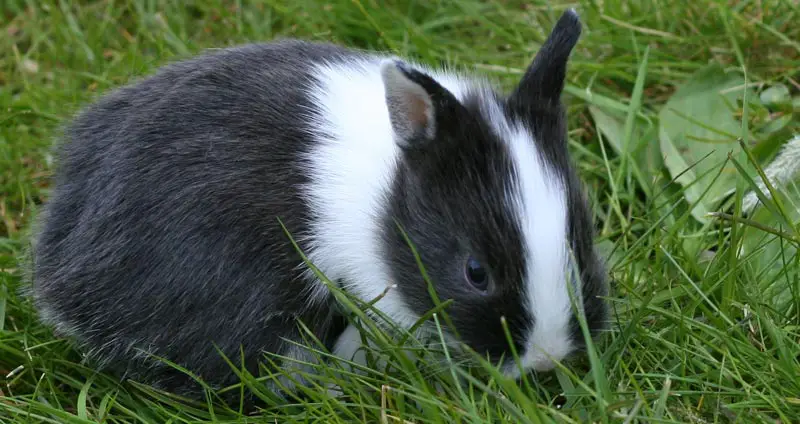Basic Appearance:
Netherland dwarfs are tiny little rabbits with a rather gnomish look. These cute little bunnies have short, thick legs, very round, stout bodies and round heads to match. Their ears are quite short, completing their baby face. Netherlands have thick, lustrous coats of fur and come in a large variety of colors.
History, Temperament, and Common Uses:
Netherland dwarfs are one of the original dwarf breeds of rabbits. They may have originated in Holland in the mid 1900’s when a breeder crossed her Polish to a wild rabbit. She eventually developed the small offspring resulting from this breeding into Netherland dwarfs. Another version is that they originated in Germany in the late 1800’s. Regardless of their past, there is no doubt about Netherlands being popular all over the rabbit world. They were recognized by the ARBA in 1969, and have risen to be one of the top three breeds in the U.S.
Netherlands used to have rather unfriendly temperaments, but breeders have worked very hard to correct this over the years. Now days many Netherlands have very nice personalities and are easy to handle. Research a breeder’s lines before making a purchase.
With their small size and irresistible faces, Netherlands are very popular as show rabbits and pets.
Grooming, Care, and Additional Notes:
Netherlands need very little grooming. Brushing your rabbit once a week should be enough to keep him looking his best. You can also go over his coat with a damp cloth or hands. This will remove any loose hairs and static. Like any rabbit breed, Netherlands will need more grooming during a molt.
The Netherland dwarf is very widely raised, and quality varies quite a bit from pets which are too trim and lanky for showing to show stoppers with sturdy round bodies and round heads.
When posing a Netherland it should not stand up high on its forelegs, showing daylight under its belly. The head should not be pushed down, either. They should sit in a natural manner, with their front paws on the table.
Netherland Dwarf At A Glance…
Recognized Varieties:
Netherland dwarfs are judged by variety. Winners of each variety then compete for Best of Group.
Self Group: black, blue, chocolate, lilac, blue eyed white, and red eyed white.
Shaded Group: sable point, Siamese sable, Siamese smoke pearl, and tortoise shell.
Agouti Group: chestnut, chinchilla, lynx, opal, and squirrel.
Tan Pattern Group: otter (black, blue, chocolate, lilac), sable marten, silver marten (black, blue, chocolate, lilac), smoke pearl marten, and tan (black, blue, chocolate, lilac).
Any Other Variety Group: broken, fawn, Himalayan, orange, and steel.
ARBA Body Type:
Compact
Approximate Size:
Up to 2 1/2 pounds.
Important Things to Look for When Buying Show Stock:
Look for a cobby, round rabbit with medium to medium-heavy bone. A Netherland dwarf should look like it has a ball for a body and another ball for a head.
The shoulders should be wide and deep, and of the same width as the hindquarters. When viewed from above there should be no taper from hindquarters to shoulders. There should be good balance of body, showing a nice looking animal with round, cobby build. On a correctly posed Netherland, the topline should show the greatest depth at the shoulders. The hindquarters should be full, rounded, and smooth.
The head should be large and in balance with the body, and round from all directions. The profile should show a continuous arc from the ears to the nose. Netherlands should have a high set head with a short neck. The ears should be short, thick enough to have good substance, well covered in fur, and set on the top of the head. They should be carried erect, have rounded tips and a strong base. Ideal length of ears is 2 inches. Look for eyes that are large, round, and bright.
Netherlands should have rollback fur. It should gently go back into position when stroked from rump to head. The coat should be soft, thick, and have plenty of gloss.
Things to Avoid:
Shoulders with width or depth not equal to hindquarters. Lack of balance. Pinched or undercut hindquarters. Protruding hips. Long or fine boned rabbits. A dewlap is a disqualification. Netherlands should not have pinched or Roman nosed muzzles. A head that does not balance with the body or is not round. Thin, bent ears, or ears lacking a complete covering of fur. Ears lying flat, crossing, or carried in a wide “V.” Ears over 2 1/2 inches are a disqualification. Fur that is very long, thin, poor texture, or flyback fur.

